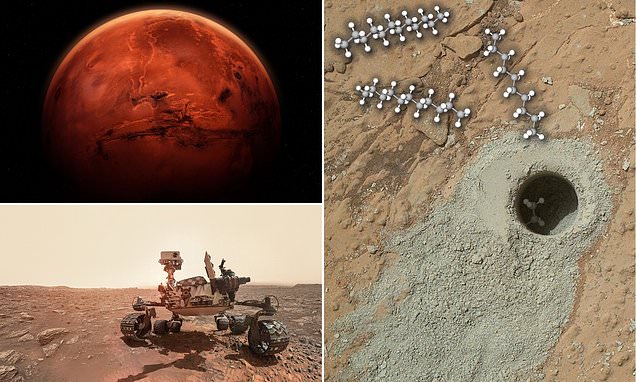
Title: Discovery of Long-Chain Alkanes on Mars: Potential Indicators of Historical Life?
NASA’s Curiosity rover has revealed fascinating new insights that may shed light on Mars’ ability to support life in the past. In a noteworthy scientific breakthrough, three long-chain alkanes — decane, undecane, and dodecane — have been identified in Martian rock samples. These organic molecules, found in picomolar concentrations, might serve as chemical biosignatures, implying that Mars may have once harbored microbial life. Nonetheless, researchers warn that these compounds could also arise from abiotic processes.
Findings in Gale Crater
The compounds were discovered in finely stratified mudstone samples retrieved from Gale Crater, a site that likely hosted a lake of liquid water around 3.5 billion years ago. The analysis was conducted using the Sample Analysis at Mars (SAM) instrument suite onboard the Curiosity rover, which performs chemical analyses directly on the Martian surface employing techniques like pyrolysis and gas chromatography–mass spectrometry (GC-MS).
Gale Crater is renowned for its extensive geological history and the presence of rich silicate clay, iron, and magnesium sulfate minerals — compounds recognized for their capacity to preserve organic materials over extended periods. The existence of these preserving minerals amplifies the scientific importance of the identified compounds.
What Are Alkanes?
Alkanes are saturated hydrocarbons composed solely of carbon and hydrogen atoms connected by single bonds. Long-chain alkanes like decane (C10H22), undecane (C11H24), and dodecane (C12H26) are typically found in crude oil and natural gas on Earth and can also be seen in biological systems, often produced as by-products of fat and cell membrane metabolism.
On Earth, similar compounds are frequently linked to living organisms and are present in fatty acids — crucial components of cell membranes. This biological association prompts interesting inquiries about their potential origin on Mars.
Biosignature or Non-Biological Formation?
The identification of these molecules does not automatically indicate the existence of life; they could just as easily result from entirely inorganic, abiotic processes. For instance, reactions involving water, carbon dioxide, and particular minerals under specific conditions can produce hydrocarbons independently of living entities.
Nevertheless, the research team emphasizes that while abiotic formation is a possibility, long-chain carboxylic acids—precursors to alkanes like those identified—are also seen as universal biochemistry products. These compounds are plentiful in the biological composition of Earth’s organisms and may function as Martian biosignatures — signs that life could have existed on the Red Planet.
Scientific Context and Future Investigations
The question of whether Mars ever hosted life is a focal point in astrobiology and planetary science. NASA’s Perseverance rover, operating in the neighboring Jezero Crater, contributes to the broader mission of seeking signs of ancient life, specifically through the collection of rock core samples intended for eventual return to Earth for detailed laboratory examination.
Curiosity’s discovery of decane, undecane, and dodecane bolsters the idea that Mars may have once provided a habitable environment. The potential for these compounds to have originated from microbial life makes them particularly compelling targets for further study.
As scientists continue to examine the distribution, concentration, and isotopic composition of these organics, future missions — particularly those involving sample return — will be vital for validating or disproving the biological origins of these molecules.
Conclusion
Although the presence of long-chain alkanes on Mars does not serve as conclusive evidence of past life, it signifies a significant advancement in our comprehension of the planet’s chemical framework. Whether these compounds were created by ancient microbes or through non-biological geochemical mechanisms, their detection highlights the necessity for continued exploration. The enigma of Mars’ history — and the possibility of life having existed there — remains one of the most intriguing scientific inquiries of our era.